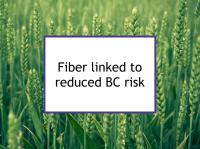Dietary fiber has been reported to be associated with lower risk of breast cancer and improved survival. These findings may not be surprising since fiber is found in many plant foods with chemopreventive components. However, fiber may also have anti-cancer effects independent of the beneficial micronutrients in high-fiber foods.
Girls with high dietary fiber intake during childhood have been reported to experience later first periods. Early menstruation has been linked to increased breast cancer risk in numerous studies. Fiber consumed during adolescence has been found to be associated with reduced incidence of benign breast disease during adulthood. Benign breast disease is an indicator of increased breast cancer risk. High consumption of dietary fiber has also been linked to low levels of inflammation (as measured by CRP) in breast cancer survivors. In addition, recent evidence suggests that high dietary fiber consumption influences the composition of the gut microbiome in ways unfavorable to breast cancer. Now a new meta-analysis of previous studies has reported that increasing fiber consumption is linearly associated with reduced risk of breast cancer.
Types of fiber
Dietary fiber consists of portions of plants that are edible but resistant to digestion. Soluble fibers (pectins, gums, mucilages) can dissolve in water and form a gel, which slows digestion. Insoluble fibers (cellulose, lignins) do not dissolve in water; they add bulk to the diet and speed up the passage of food and waste. There is some evidence that soluble fiber may reduce breast cancer risk more than insoluble fiber. Please see our article on fiber for lists of foods with high fiber content.
Latest research links high fiber to lower BC risk
The meta-analysis of previous studies referenced above was designed to investigate the association between dietary fiber intake and breast cancer risk. To conduct the analysis, the authors used data from 10 relevant studies retrieved through the PubMed and Web of Science databases.
Dietary fiber intake was found to be negatively associated with risk of breast cancer in a dose-dependent manner. The authors found a statistically significant linear relation between increasing dietary fiber and lower risk of breast cancer: a 10 g per day increase was associated with a 4.7% reduction in breast cancer risk. Additional analysis also determined that the breast cancer dietary fiber–attributed percentage was 33.33% in Asia, 16.28% in North America and 9.89% in Europe. This result may demonstrate that the higher fiber content typical of Asian diets translates into lower breast cancer risk. The authors conclude that dietary fiber may be associated with lower breast cancer risk, especially if intake is high.
Please see our article on fiber for more information.
